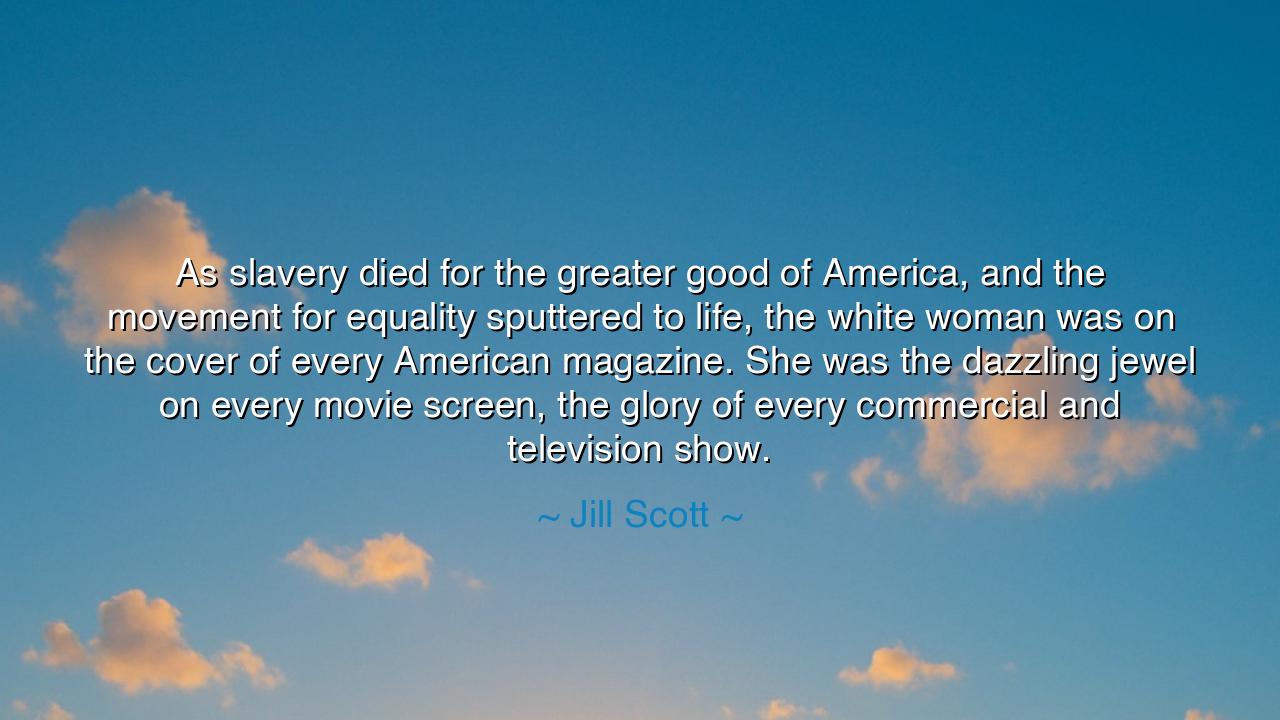
As slavery died for the greater good of America, and the movement
As slavery died for the greater good of America, and the movement for equality sputtered to life, the white woman was on the cover of every American magazine. She was the dazzling jewel on every movie screen, the glory of every commercial and television show.






When Jill Scott wrote, “As slavery died for the greater good of America, and the movement for equality sputtered to life, the white woman was on the cover of every American magazine. She was the dazzling jewel on every movie screen, the glory of every commercial and television show,” she was not merely describing an image — she was unveiling a truth about power, perception, and exclusion. Her words are the lament of a poet and the insight of a prophet, for they reveal how the struggle for freedom often births new hierarchies of beauty and worth. While the chains of slavery were broken, the chains of representation remained — invisible, but no less binding.
In the era that followed emancipation, when the nation sought to rebuild its soul, it did not immediately confront its deepest wounds. The Black body, once enslaved, was now erased. The Black woman, who had carried both her people’s labor and their hope, was pushed to the margins of America’s rebirth. Instead, the image of the white woman — radiant, pure, and unblemished — rose to become the nation’s new emblem of virtue and aspiration. Scott’s words recall that transformation: the shift of America’s gaze from the field to the screen, from bondage to illusion. And in that illusion, the nation found comfort — a vision of beauty that denied its own diversity, that forgot the women who had built its foundations.
This was not the beauty of universal womanhood; it was a political construct, born from centuries of domination. In magazines, advertisements, and films, whiteness became synonymous with femininity, purity, and desirability. The Black woman — once the unseen backbone of America’s survival — was rendered invisible, or worse, caricatured. She was not the face of progress; she was the shadow of its conscience. Scott’s words strike at this hypocrisy: that even as America spoke of freedom and equality, it continued to worship an image that excluded the very people whose suffering made that freedom possible.
Consider the story of Hattie McDaniel, the first Black woman to win an Academy Award, for her role in Gone with the Wind (1939). Though she broke barriers, she was celebrated not for portraying a free woman, but for playing a servant — a remnant of the old order. She was denied entry to the ceremony’s main hall because of her race. Her victory, though historic, revealed the bitter truth that representation without equality is a hollow triumph. While her image was projected on screens across the world, her humanity was still restrained by society’s prejudice. Jill Scott’s words remind us that progress measured only in symbols is not progress at all.
Yet within this sorrow lies resilience. The Black woman, denied her rightful place in the nation’s imagination, began to create her own mirrors — in art, in music, in poetry. From Billie Holiday’s haunting songs to Maya Angelou’s soaring verse, from the regal defiance of Angela Davis to the grace of Cicely Tyson, these women reclaimed what the nation refused to see. They became their own storytellers, their own architects of beauty and truth. In their strength, the myth of exclusivity began to crumble. And though the struggle continues, their legacy has become a counter-image — one that honors every hue, every voice, every story that once lived in silence.
Scott’s reflection is not only historical; it is spiritual. It asks us to confront the idols we still worship — the images that shape our desires and define our worth. True equality, she reminds us, is not achieved when new faces appear on covers, but when every person, regardless of race or background, is seen as a reflection of divine dignity. Representation is not a luxury; it is a form of justice. For to erase a people’s image is to deny their existence, and to restore it is to restore their humanity.
And so, let this be the teaching passed forward: freedom without inclusion is unfinished work. Each generation must examine the faces it celebrates and the voices it silences. Ask yourself — who is absent from the story you tell? Whose beauty, whose wisdom, whose courage goes unrecognized? The task is not only to make space but to honor truth — to see all people as part of the same sacred tapestry. For a nation that crowns only one kind of woman betrays its own promise, but a nation that lifts every face, every story, every color into the light — that is a nation truly reborn in equality.






AAdministratorAdministrator
Welcome, honored guests. Please leave a comment, we will respond soon